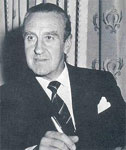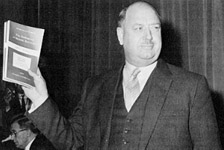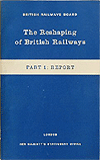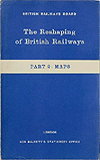|
|
 |
Britain's Railways 1825 - Present | |||||||||||||||||||||||||||||||||||||||||||||||||||||||||||||||||||||||||||||||||||||||||||||
|
||||||||||||||||||||||||||||||||||||||||||||||||||||||||||||||||||||||||||||||||||||||||||||||
|
Early days 1825 - 1838 The building of a railway involved the haphazard process of a private company getting a bill through parliament. Many of these bills were rejected but plenty of them went through, not always the best routes, this depended on the local MPs & landowners, for whatever reason, showing particular favouritism for a line & pulling a few strings. The government did not control this process & there was no central planning. The government was unable to make major decisions & had no influence over the new emerging major railway companies, uneconomic lines & duplicated routes were approved & built. Conveyance of Mails Act 1838 The government was forced to be involved in the railways when, in 1838, the state owned Post Office wanted a fair price for the carriage of the mail. The Conveyance of Mails Act was passed in 1838 & was one of the first railway legislations. The Regulation of Railways Act 1840 This act was passed on 10th August 1840. The act introduced government regulation to the rapidly expanding railways. The Railways Department of the Board of Trade was created for this. Later became Her Majesty's Railway Inspectorate. Some of the measures were - No railway to be opened without notice. Returns to be made by railway companies. Appointment of Board of Trade inspectors. Railway byelaws to be approved by the Board. Prohibition of drunkenness by railway employees. Prohibition of trespass on railways. |
||||||||||||||||||||||||||||||||||||||||||||||||||||||||||||||||||||||||||||||||||||||||||||||
 British
Transport Commission 1948 - 1962 British
Transport Commission 1948 - 1962 |
||||||||||||||||||||||||||||||||||||||||||||||||||||||||||||||||||||||||||||||||||||||||||||||
|
The British Transport Commission was created by Clement
Attlee's post-war Labour government as a part of its nationalisation
programme. The commission was to oversee railways, canals and road freight transport in Great Britain. Its general duty under the Transport Act 1947 was to provide an efficient, adequate, economical and properly integrated system of public inland transport & port facilities within Great Britain for passengers and goods. The British Transport Commission came into operation on 1 January 1948. Chairmen - Lord Hurcomb (1947 - 1953) Gen Sir Brian Robertson (1953 - 1961) Dr Richard Beeching (1961 - 1963) Its main holdings were the networks and assets of the four national regional railway companies (LNER, LMS, SR, GWR) - Regions - Eastern Region (ER) (Southern LNER lines) North Eastern Region (NER) (Northern LNER lines in England and all ex LMS lines east of Skipton) London Midland Region (LMR) (LMS lines in England and Wales and most ex LNER lines west of Skipton) Scottish Region (ScR) (LMS and LNER lines in Scotland) Southern Region (SR) (SR lines) Western Region (WR) (GWR lines) It also took over 55 other railway undertakings, 19 canal undertakings and 246 road haulage firms, as well as the work of the London Passenger Transport Board. The nationalisation package also included the fleets of private owner wagons, which industrial companies had used to transport goods on the railway. 1955 Modernisation Plan In 1955 a major modernisation programme costing £1.2 billion was authorised by the government. The main areas for modernisation were - Electrification of main lines, in the Eastern Region, Kent, Birmingham and Central Scotland. Large scale dieselisation. New passenger and goods rolling stock. Re signalling and track renewal. Closure of small number of duplicated lines lines. The Modernisation Plan was published in December 1954, intended to bring Britain's railways into the 20th century. A government White Paper produced in 1956 stated that modernisation would help eliminate BR's financial deficit by 1962. The aim was to increase speed, reliability, safety and line capacity, through a series of measures which would make services more attractive to passengers and freight operators, recovering traffic that was being lost to the roads. Unfortunately lots of different classes locomotives were bought, some experimental & marshalling yards were built when wagon load freight was already being replaced by train load workings, which do not need complex shunting and reforming. This proved costly By the late 1950s the British Transport Commission was in financial difficulties, mainly due to the economic performance of the railways. It was said to have been an overly bureaucratic system of administering transport services. It was abolished by Harold Macmillan's Conservative government under the Transport Act, 1962 and replaced by five successor bodies with effect from 1st January 1963. Successor Bodies - British Railways Board (railways, hotels and some shipping) British Transport Docks Board (docks) British Waterways Board (inland waterways) London Transport Board (London buses and the London Underground) Transport Holding Company (shipping, travel and road transport) |
||||||||||||||||||||||||||||||||||||||||||||||||||||||||||||||||||||||||||||||||||||||||||||||
|
||||||||||||||||||||||||||||||||||||||||||||||||||||||||||||||||||||||||||||||||||||||||||||||
 The British
Railways Board 1963 - 2001 The British
Railways Board 1963 - 2001 |
||||||||||||||||||||||||||||||||||||||||||||||||||||||||||||||||||||||||||||||||||||||||||||||
|
The British Railways Board was created on 1 January 1963
under the Transport Act 1962 by Harold Macmillan's Conservative government. It was to take over the railway responsibilities of the British Transport Commission, which was dissolved at the same time. The British Railways Board was a nationalised company responsible for most railway services in Great Britain, trading under the brand name British Railways. From 1965, British Rail. It was a statutory corporation, consisting of a chairman and nine to fifteen other members, who were appointed by the Secretary of State for Transport. The Minister of Transport Ernest Marples announced in the House of Commons that Beeching would be the first Chairman of the British Railways Board as from 1 June. Chairmen - Dr Richard Beeching (1963-1965) Sir Stanley Raymond (1965-1967) Sir Henry Johnson (1967-1971) Sir Richard Marsh (1971-1976) Sir Peter Parker (1976-1983) Sir Robert Reid (1983-1990) Sir Bob Reid (1990-1995) John Welsby (1995-1999) Sir Alistair Morton (1999-2001) |
||||||||||||||||||||||||||||||||||||||||||||||||||||||||||||||||||||||||||||||||||||||||||||||
 Earnest
Marples Earnest
Marples |
||||||||||||||||||||||||||||||||||||||||||||||||||||||||||||||||||||||||||||||||||||||||||||||
|
A road builder by trade, he became the Minister of Transport
between 14th October 1959 & 16th October 1964. To avoid a conflict of interest he sold his controlling shares in his road construction company, Marples-Ridgeway Ltd, as soon as he became Minister of Transport. He was required by law to buy back the shares after he ceased to hold office, at the original price. It was found out later that the purchaser was his wife. In 1959 he had given the go ahead for the the M1 which Marples-Ridgeway was given the contract to build. This originally ran from London to Nottingham, closely following the London to Nottingham railway line. Marples closed the line leaving no other way to get from London to Nottingham than by road. In the early 70s his assets were re valued, this was going to cost him & he had been asked to pay nearly 30 years overdue tax. Just before the beginning of the tax year in 1975 he decided to do a runner in the middle of the night & managed to move £2 million from Britain through his Lichtenstein company. For the next ten years the Treasury froze his assets, but most of them were in Monaco and Lichtenstein anyway. He was wanted for tax fraud & he was being sued by tenants of his slums & by former employees. He never returned to Britain, living the rest of his life in his French chateau. |
||||||||||||||||||||||||||||||||||||||||||||||||||||||||||||||||||||||||||||||||||||||||||||||
 Dr Richard
Beeching Dr Richard
Beeching |
||||||||||||||||||||||||||||||||||||||||||||||||||||||||||||||||||||||||||||||||||||||||||||||
|
Chairman of the British Railways Board In 1963 he was set on by Marples, his brief was to make the railways pay. He surveyed the network to find out which parts made profit and which parts operated at a loss. Beeching's plans were controversial with trade unions, Labour opposition & the public, but he was unrepentant and argued that too many lines were running at a loss. He was expected by the government to solve the railways problems quickly. Beeching said "I suppose I'll always be looked upon as the axe man, but it was surgery, not mad chopping." Although he had helped to modernise many aspects of the railway network, for example block trains which did not require time consuming shunting. Imperial Chemical Industries (ICI) In 1948 he joined ICI as Personal Technical Assistant, working on the production lines improving efficiency and reducing production costs. He was later appointed to the Terylene Council, and eventually to the board of ICI Fibres Division. In 1953 he went to Canada as vice-president of ICI (Canada) Ltd and given overall responsibility for a plant in Ontario. In 1955 he became chairman of ICI Metals Division & in 1957 became ICI Technical Director & Development Director. Return to ICI It is unknown whether Beeching left politics by arrangement with the government or if he was sacked. Beeching was to return to ICI in June 1965. It was revealed to the House of Commons in November 1965 that Beeching had been sacked by the Minister of Transport Tom Fraser (October 16, 1964 - December 23, 1965) Beeching denied this, saying that he had returned early to ICI because he would not have had enough time to undertake an in depth transport study. |
||||||||||||||||||||||||||||||||||||||||||||||||||||||||||||||||||||||||||||||||||||||||||||||
 The
Reshaping of British Railways - Part 1 Report The
Reshaping of British Railways - Part 1 Report |
||||||||||||||||||||||||||||||||||||||||||||||||||||||||||||||||||||||||||||||||||||||||||||||
|
On 27 March 1963, Dr Beeching published his report on the
future of the railways. Entitled The Reshaping of British Railways it gave the first accurate description of the state of the network. The report showed that only half the routes covered the cost of operating them & that half the stations produced about 95% of all the revenue. So as to improve British Railway's accounts of between £115m and £147m. He asked for - The closure of one-third of the country's 7,000 railway stations. The withdrawal of 5,000 route miles of passenger services (annual train mileage of 68 million) saving £18m per year. The shedding of around 70,000 British Railways jobs over three years. The scrapping of over 330,000 goods wagons. Click here for list of West Yorkshires stations The government were quick to act on the reduction part of the plan. Most of the closures were carried out under the Wilson Labour Government of 1964 to 1970. |
||||||||||||||||||||||||||||||||||||||||||||||||||||||||||||||||||||||||||||||||||||||||||||||
 The
Reshaping of British Railways - Part 2 Maps The
Reshaping of British Railways - Part 2 Maps |
||||||||||||||||||||||||||||||||||||||||||||||||||||||||||||||||||||||||||||||||||||||||||||||
|
On 16 February 1965, Beeching announced the second stage of
his reorganisation of the railways. Of 7,500 miles of trunk railway throughout Britain, only 3,000 miles should be selected for future development & invested in. This policy would result in traffic through Britain being routed through nine selected lines - Traffic to Birmingham, Manchester, Liverpool and Scotland would be routed through the West Coast Main Line running to Carlisle and Glasgow. Traffic to the north-east would be concentrated through the East Coast Main Line which was to be closed north of Newcastle. Traffic to Wales and the West Country would go on the Great Western Main Line, then to Swansea and Plymouth. Beeching said there was still too much duplication in the railway network - Of the 7,500 miles of trunk routes, 3,700 miles involved a choice between two routes. 700 miles involved a choice between three routes. A further 700 miles involved a choice between four routes. These proposals were rejected by the government, who were not so quick to act on the investment part of the plan. He said that closing the branch lines would save £30m but they ended up only saving £7m. |
||||||||||||||||||||||||||||||||||||||||||||||||||||||||||||||||||||||||||||||||||||||||||||||
 British Rail Sectorisation 1982
British Rail Sectorisation 1982 |
||||||||||||||||||||||||||||||||||||||||||||||||||||||||||||||||||||||||||||||||||||||||||||||
|
In 1982 under sectorisation, the regions of BR were phased
out. Regions to be phased out - Eastern Region North Eastern Region London Midland Region Scottish Region Southern Region Western Region The organisation was converted from a regional structure to a sector based structure - Passenger sectors - Inter City (express services) Network South East (London commuter services) Regional Railways (North West, North East, Scotland, South Wales and West, Valley Lines, Merseyrail electrics, Central ) Freight sectors - Trainload Freight (Trainload freight coal, ballast, petroleum etc) Railfreight Distribution (Non-trainload freight) Freightliner (Intermodal traffic containers) Rail Express Systems (parcels traffic) Maintenance & Engineering Sector - BRML (British Rail Maintenance Limited) The new sectors were further subdivided into divisions & the BR Blue identity was phased out. Infrastructure remained the responsibility of the Regions until the Organisation for Quality initiative in 1991 when this was also transferred to the sectors. |
||||||||||||||||||||||||||||||||||||||||||||||||||||||||||||||||||||||||||||||||||||||||||||||
 Organisation for Quality initiative 1991
Organisation for Quality initiative 1991 |
||||||||||||||||||||||||||||||||||||||||||||||||||||||||||||||||||||||||||||||||||||||||||||||
|
Introduced on July 29 1991, it originates from the European
Council Directive 91/440/EEC. This was created to make it a legal requirement for independent companies to be able to apply for non discriminatory track access or running powers on a European Union country's track. The result was separating rail infrastructure from operation of rail services - Operational autonomy for railway operators. Separation of the infrastructure from service operations. The minimum requirement is separate accounting between the two sections. Open access for international undertakings. Introduction of track access charges and a sound financial basis for railway operators. The directive is not a mandate & does not force member states to privatise their railways - The directive “requires member states to grant the rail companies independence from government. & introduce commercial management techniques & to separate the management of infrastructure from transport management”. The main aim was the de-monopolisation of European railways & increasing competitiveness, i.e. liberalisation. |
||||||||||||||||||||||||||||||||||||||||||||||||||||||||||||||||||||||||||||||||||||||||||||||
 Privatisation of British Rail 1993
Privatisation of British Rail 1993 |
||||||||||||||||||||||||||||||||||||||||||||||||||||||||||||||||||||||||||||||||||||||||||||||
|
British Coal and British Rail (Transfer Proposals) Act
1993 - On the 19th January 1993, the conservative government set in motion the British Coal and British Rail (Transfer Proposals) Act 1993. This act enabled the Secretary of State to issue directions for the disposal of holdings to the relevant Board. This act was required so as the board could legally sell off its assets within the rules of the Transport and Railways Acts. The operations of the British Railways Board (BRB) were broken up and sold off. This allowed for the introduction of the Railways Act 1993. The Railways Act 1993 - This was was introduced by John Major's Conservative government and passed on 5 November 1993. It provided for the restructuring of the British Railways Board (BRB). A few residual responsibilities of the BRB remained with BRB (Residuary) Ltd. The legislation enabled the Secretary of State for Transport John MacGregor to transfer separated parts of the railway to the private sector. Passenger rail services were franchised to private companies i.e. Virgin, Veolia Transport & the bus companies Stagecoach and National Express. Rolling stock & operators - The passenger & rolling stock were owned by three rolling stock leasing companies (ROSCOs), Angel Trains, Porterbrook & HSBC Rail. These were sold to management buyout teams. Rolling stock operating company's own & maintain railway engines & carriages which are leased to train operating companies who operate the trains. Passenger operators are called train operating companies or TOCs. Freight operators are called freight operating companies. There are now several companies operating trains on Britain's railways. Railtrack took control of the railway infrastructure on 1 April 1994 & was floated on the Stock Exchange in May 1996. British Rail's track maintenance and renewal operations were sold to private companies, who contract to Railtrack. Railtrack was really a group of companies who owned the track, signalling, tunnels, bridges, level crossings & most stations. The accidents at Southall in 1997 & Ladbroke Grove in 1999, exposed the effects fragmentation of the railway had on safety and maintenance. The Hatfield crash on 17 October 2000 was the final nail in the coffin for Railtrack. The Railtrack board panicked in the wake of Hatfield, most of the engineering skill of British Rail had been sold off into the maintenance and renewal companies. Railtrack had no idea how many more accidents were waiting to happen & hastily introduced ill informed restrictions bringing the railway to a virtual standstill. Railtrack Group, Railtrack's parent company, went into voluntary liquidation on 18 October 2002. |
||||||||||||||||||||||||||||||||||||||||||||||||||||||||||||||||||||||||||||||||||||||||||||||
 Network Rail 2002.
Network Rail 2002. |
||||||||||||||||||||||||||||||||||||||||||||||||||||||||||||||||||||||||||||||||||||||||||||||
|
The Railtrack business & £7 billion debt was sold to
Network Rail for £500 million on 3rd October 2002. Network Rail was formed by the government to acquire and own Railtrack plc. It now owns the infrastructure, including the railway tracks, signals, tunnels, bridges, level crossings and most stations. |
||||||||||||||||||||||||||||||||||||||||||||||||||||||||||||||||||||||||||||||||||||||||||||||
 BRB
(Residuary) Ltd 2001 - 2013. BRB
(Residuary) Ltd 2001 - 2013. |
||||||||||||||||||||||||||||||||||||||||||||||||||||||||||||||||||||||||||||||||||||||||||||||
|
Successor to the British Rail Property Board, BRB dealt with the remaining land & buildings etc which were surplus to
operational needs but which were omitted from the privatisation process.
It was in the ultimate charge of the Department for Transport. BRB (Residuary) Ltd (BRBR) was abolished on 30 September 2013, following the Cabinet Office’s Public bodies review. BRBR’s continuing functions have been dispersed to various successor bodies - The Highways Agency Historical Railways Estate Responsible for the historical railways estate (formerly known as the Burdensome Estate). This includes legacy bridges, abutments, tunnels, cuttings, viaducts and similar properties associated with closed railway lines, and sales. London & Continental Railways Ltd (LCR) Responsible for former BRBR properties with development potential, or which might be used for future railway projects, office buildings (The Axis, Birmingham; The Railway Technical Centre, Derby; Piccadilly Gate, Manchester). LCR is also acting as the managing agent on behalf of DfT for Waterloo International Terminal, North Pole International Depot and Temple Mills Bus Depot. Network Rail Responsible for a small number of properties closely associated with the operational railway that should have transferred during railway privatisation or which should be maintained by the owner of the operational railway, various memorials commemorating those killed in railway accidents or rail employees killed during the world wars, and Old Dalby test track in Leicestershire and Nottinghamshire. The Rail Safety and Standards Board (RSSB) The owner and holder of the intellectual property rights of the ‘RDDS managed documentation’ (consisting of drawings and maintenance documents and reports, generally relating to rolling stock built before 1996). The Department for Transport (DfT) Responsible for ill health claims from former British Rail (BR) employees. |
||||||||||||||||||||||||||||||||||||||||||||||||||||||||||||||||||||||||||||||||||||||||||||||
 Present Day Present Day |
||||||||||||||||||||||||||||||||||||||||||||||||||||||||||||||||||||||||||||||||||||||||||||||
|
As far as I know this is the state of play at present - 25 passenger train operators, 7 freight operators, 4 rolling stock operators & 1 track & signalling company. The only remnants from British Rail are the Transport police. |
||||||||||||||||||||||||||||||||||||||||||||||||||||||||||||||||||||||||||||||||||||||||||||||
|
Home | ||||||||||||||||||||||||||||||||||||||||||||||||||||||||||||||||||||||||||||||||||||||||||||||